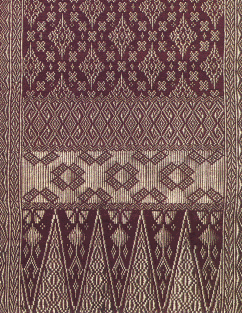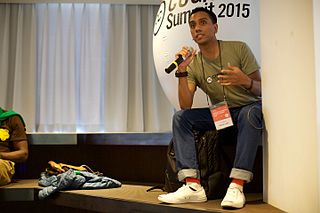
Syed Muhammad al Naquib bin Ali al-Attas is a Malaysian Muslim philosopher. He is one of the few contemporary scholars who is thoroughly rooted in the traditional Islamic sciences and studies theology, philosophy, metaphysics, history, and literature. He pioneered the concept of Islamisation of knowledge. Al-Attas' philosophy and methodology of education have one goal: Islamisation of the mind, body and soul and its effects on the personal and collective life on Muslims as well as others, including the spiritual and physical non-human environment.

The National Museum is in Jalan Damansara, in Kuala Lumpur, Malaysia. The museum is close to Perdana Lake Gardens and it provides an overview of Malaysian history and culture. Its façade comprises elements from both traditional Malay and modern features. It was inaugurated on 31 August 1963, and it serves as a repository of Malaysia's cultural and historical heritage.

The Malay Heritage Museum is a museum located within Universiti Putra Malaysia (UPM), it hosts a diverse array of exhibits, encompassing manuscripts, traditional attire, weaponry and architectural remnants from various Malay regions.

Federal Route 3 is a main federal road running along the east coast of Peninsula Malaysia. The 739 kilometres (459 mi) federal highway connects Rantau Panjang in Kelantan until Johor Bahru in Johor. The entire FT3 highway is gazetted as a part of the Asian Highway Network route 18.

Songket or sungkit is a tenun fabric that belongs to the brocade family of textiles of Brunei, Indonesia, Malaysia, and Singapore. It is hand-woven in silk or cotton, and intricately patterned with gold or silver threads. The metallic threads stand out against the background cloth to create a shimmering effect. In the weaving process the metallic threads are inserted in between the silk or cotton weft (latitudinal) threads in a technique called supplementary weft weaving technique.

Syed Thajudeen Shaik Abu Talib is a Malaysian painter. He is known for his large scale mural paintings of epic proportions set in period landscapes. A distinctive stylisation, romantic treatment of subject matter and the rich colours as in the Ajanta cave paintings of Maharashtra and of the Mughal are apparent in his works. This, together with the traditional visual arts' integral connection with literature, music, dance, sculpture and philosophy, helped shape Syed's early works. His works, as individualistic as they are, attempt to evoke a state of rasa, or heightened mood that belongs to a larger tapestry and sensibility of Asian artistic traditions. In many instances where his favourite subject matters deal with women and love, they share the same archetypal symbols and metaphors.

Ungku Abdul Aziz bin Ungku Abdul Hamid was a Malaysian economist and university professor. He was the 3rd Vice-Chancellor of the University of Malaya from 1968 to 1988 and the 1st General Director of the Council on Language and Literature of Malaysia from 1956 until 1957. He was the first to be awarded the title of Royal Professor in 1978.

Seni Gayung Fatani is a martial art, specifically a style of silat from Malaysia based on the art of war, the combination punch and kick striking, joint-locking and grappling techniques, and various type of melee weapon. In Malay, the word seni means art and gayung is a word for martial arts, synonymous with silat. Fatani means wise in Arabic and was chosen in 1976 by the councils of Guru Tua. The first grandmaster of the silat is Tuan Guru Hj Anuar Abd. Wahab (1976–2009). The second grandmaster was Tuan Guru Aminuddin Haji Anuar (2009–2023) and the current grandmaster of Seni Gayung Fatani Malaysia is Grandmaster Mohd Safwan Abu Hassan.
Tuan Haji Anuar bin Haji Abdul Wahab AMN was a grandmaster of Seni Gayung Fatani who, during his time, revolutionized the teaching and practice of silat in Malaysia.
Tan Sri Zainal Abidin bin Ahmad or better known by the moniker Za'aba, was a Malaysian writer and linguist. He modernised the Malay language with the publication of a series of grammar books entitled Pelita Bahasa in 1936 at the Sultan Idris Training College. The book contained guidelines in modernising the structure of classical Malay, transforming it into the language that is in use today: the most significant change was the switch from the conventional passive to the modern active form of syntax.

The Islamic Arts Museum Malaysia is a museum in Kuala Lumpur, Malaysia. It was officially opened on 12 December 1998. The museum is the largest museum of Islamic arts in Southeast Asia with more than seven thousands artifacts from the Islamic world.

The National Art Gallery of Malaysia is a public art gallery in Kuala Lumpur, Malaysia.

The Royal Malaysia Police Museum is a museum that showcases the history of the Royal Malaysia Police, located in Kuala Lumpur, Malaysia. The museum includes exhibits from the history of the Royal Malaysia Police since its origins under British colonial rule until the 1970s. It is open daily, except Monday, from 1000 to 1800 hours, and admission is free.

Abdul Muid bin Abdul Latif was a Malaysian-based web designer, graphic designer and digital artist, who is known for promoting the cultural elements of the Southeast Asia from Batik and Songket into his commercial works and artworks.

Unplugged is a live album by Malaysian recording artist Siti Nurhaliza. It was released in multiple formats, both physical and digital in Malaysia on 30 June 2015. The main live tracks were all taken from her 2015 unplugged concert at Istana Budaya on 7 April 2015. The CD, digital download and LP record versions of the album however come with three new bonus songs, "Menatap dalam Mimpi", "Engkau" ("You") and "Mikraj Cinta". All were recorded specifically to accompany the three audio releases.
William Young Willetts was a British scholar of South-East Asian art studies who wrote several books and served as curator of the National University of Singapore art museum from 1963 to 1972. During his years in Singapore, he was the impetus behind the gathering of ceramic collectors and artists that led to the founding of the Southeast Asian Ceramic Society. He curated the society's first exhibition on Southeast Asian ceramics, which showcased ceramics from both the museum as well as members' collections, and authored the accompanying catalogue. The catalogue won the praise of Henry D. Ginsburg who reviewed it in the Journal of the Siam Society, noting Willetts' "appreciation of the aesthetic qualities of these previously unsung artefacts of the Asian ceramics world." When the decision was made to close the National University of Singapore's art museum in 1972, Willetts relocated to Kuala Lumpur where he served as Curator of the Muzium Seni Asia, the Museum of the Arts of Asia, University of Malaya. He "passed away in the Universiti Malaya Hospital in Kuala Lumpur, Malaysia on 29 January 1995 at the age of 76."

Raja Rajeswari Setha Raman is a Malaysian poet and translator. Tamil by ethnicity. She is also a lecturer of the Teacher Education Institute, Malay Language Campus.
Yaakub Isa was a Malaysian teacher, writer, scholar of the Malay language and literature.

Dato' Chuah Thean Teng, also known as Cai Tianding, was a Malaysian artist who is credited with the development of batik as a painting technique.
Thiagarajan Kanaga Sabapathy, better known as T.K. Sabapathy, is a Singaporean art historian, curator, and critic. Sabapathy has written, researched, documented, and supported contemporary visual art in Singapore and Malaysia for four decades. He has held positions at the National University of Singapore, Nanyang Technological Institution, and National Institute of Education as a lecturer of art history. Sabapathy further established and headed pioneering art research facilities in Singapore, such as the Contemporary Asian Art Centre (2001–2004) and subsequently, Asia Contemporary (2015–).


















